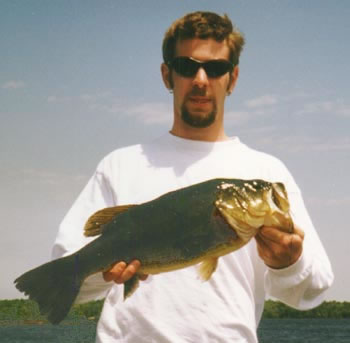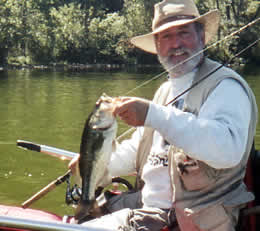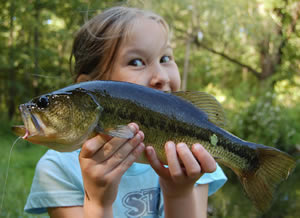Summertime Largemouth Bass Fishing in New Jersey is Heating Up!By Chris SmithSenior Fisheries Biologist July, 2001
The largemouth bass fishery of New Jersey is overshadowed in comparison to the fisheries of such states as Florida, Texas and California. No, we are not going to produce the next world record, nor will an angler catch a bass over 20 pounds, or even catch a five fish limit in a tournament that will surpass the 45 pound mark, as was done in a recent B.A.S.S. sponsored tournament in Florida. What New Jersey does have to offer is an overall quality fishery that continues to improve each year. Assunpink Lake Wildlife Management Area, one of New Jersey's "Trophy Bass Lakes", continues to produce largemouth bass in excess of 7 pounds every year. Tournament results from this lake show a 133% increase in the number of 5 pound bass. In 1999 there were 12 bass over 5 lb. caught and in 2000 there were 28. There were 19 tournaments held each year. Though Assunpink Lake ranks as one of the top lakes in New Jersey it is by far not the only lake. New Jersey has over 400 publicly accessible lakes ranging in size from .25 to over 2600 acres. The majority of these lakes contain excellent bass fishing opportunities when approached the correct way. A successful day on the water is determined by essentially three factors. These factors include knowing where to fish, when to fish and what to fish with. Where to FishThe first thing that an angler needs to do when deciding where to fish is know the type of lake they are fishing. New Jersey lakes are generally distinguished by geographic location. Typically, lakes in the northern part of the state are deeper, clearer and cooler than lakes of southern New Jersey which are usually shallow, stained and warmer. With this in mind, an angler must first determine what depth they plan to fish.Like all species of fish, largemouth bass migrate to different areas of the lake throughout the seasons. The key to finding and catching largemouth bass is knowing where they are during each particular season. The season that we will focus on is summer. However, knowledge of where largemouth bass are located in all seasons is helpful.
Spawning occurs from mid-April through early June, depending on temperature. Bass spawn when the water temperature reaches 62-65 degrees Fahrenheit. When the spawn is completed bass will remain in close proximity to the spawning areas for a number of weeks. This post-spawn period is usually a difficult time to catch largemouth bass because they are recuperating from the spawn. Usually male bass, which guard the newly hatched young, stay in the shallows longer than the females. Larger female bass will move back to deeper water where they remain throughout much of the summer, on occasion returning to shallow waters to feed. Though many fish move to deeper water during the summer, a large percentage of the bass population remains in shallow water. As water temperature declines in autumn, largemouth bass are stimulated to feed in preparation for winter. Autumn feeding activity occurs in shallow water in close proximity to deep water. The determining factor of how deep bass will travel is the amount of dissolved oxygen present in the water. During the summer many lakes go through a stratification, or layering, process. This means that warmer water remains on top and cooler, denser water remains on the bottom. Oxygen depletion can be particularly severe in productive lakes which become stratified during the summer. The fish cannot live in an oxygen-depleted area for extended periods of time.
As already stated, largemouth bass spend the summer in both shallow and deeper water. This appeals to many anglers because some like to fish shallow water and others prefer to fish in deeper waters. During the summer, those anglers preferring to fish shallow should concentrate on structure that is visible to the eye. This includes grass beds, fallen trees, standing trees, docks and rocky banks. These areas can be targeted from shoreline or from a boat. Bass will relate to grass beds, either on the edge or in the middle of the bed, depending on the weather. On sunny days, fish will relate to structure more tightly than on a cloudy day. Cloudy days or low light will usually cause bass to roam farther away from cover in search of food. Anglers fishing deeper water should look for points, offshore humps, roadbeds and wood or rock piles on the bottom. Deep-water anglers can locate structure by using bathymetric charts and depth finders. This type of fishing is most effective when a boat is used. When to FishMost anglers focus their fishing efforts during the summer - the weather is more favorable, the days are longer and vacations are taken. Unfortunately, the amount of time the average angler can dedicate to fishing is often limited by other responsibilities. Hence, any time spent on the water fishing is quality time.All anglers want to make the best of their limited time, and knowing when to target largemouth bass can increase success. For a reference, anglers may want to consult a lunar table, which can be found in fishing publications, before they go fishing. These will tell the peak fishing hours for that particular day. The best summer fishing is usually early in the morning and in the evening. However, often the middle of the day will be the best time to catch largemouth. Largemouth bass will most actively feed early and late in the day, during reduced light conditions. Targeting these times can make an angler more successful. During the middle of the day, success is often a result of the weather. For example, a cloudy day will result in increased fish activity. A sunny day will generally result in less active fish that are relating tighter to cover. This is not to say that a sunny day will be unsuccessful and a cloudy day will always be rewarding. Weather conditions determine how an angler should approach the fish for that particular day. On a cloudy day, anglers can fish farther away from cover with faster moving lures. Sunny days require the angler to fish tighter to cover and at a slower pace. Following this trend in largemouth bass behavior an angler can determine where they are going to fish on that particular day at a given time. What to FishThe most frequently asked question that any angler receives is, "What did you catch them on?" When deciding what to use an angler must first consider whether they want to use live bait or artificial lures. An angler that is just starting bass fishing may want to begin by using live bait. More experienced anglers and those fishing in tournaments prefer using artificial lures. The type of bait, whether live or artificial, is a matter of personal preference and dependant on fishing style. Some anglers prefer a more laid-back approach using live bait, while others prefer the more active approach using artificial lures.The best live baits for largemouth bass are golden shiners, night crawlers and small baitfish. These baits can be fished using 1/0 to 4/0 hooks, depending on the size of the bait, and small split-shot weights pinched onto the line about one foot above the hook. A float is often a good choice when attempting to keep bait off the bottom or out of vegetation. It is helpful if an angler carries bait of different sizes to determine which is more effective. Most anglers targeting largemouth bass use artificial lures. Under tournament regulations only artificial lures are permitted. Using artificial lures is more challenging than using live bait. The reason for this is that there are so many baits to choose from. Artificial lures are broken down into a few major categories. Each category has a useful application. To the bass angler, these lures are tools. Summertime is an excellent time of year for using artificial lures because so many different baits can be effective. The major categories of lures include jigs, spinnerbaits/buzzbaits, crankbaits, soft plastic worms, minnow baits and topwater. These baits all have a time and place. Each category has both shallow water and deepwater applications. When fishing for summertime bass, anglers should take a simple approach. Using the same variety of baits in all waters will reduce the amount of tackle needed. It is also suggested that anglers limit themselves to a few choice colors and sizes, which are appropriate for all conditions. Suggested lure type, size, and colors are listed below.
If an angler follows this basic list of lures and applications the next trip fishing for largemouth bass will be rewarding. Further information regarding techniques of bass fishing can be found in specialty magazines and videos. Visiting a local tackle shop near the lake you are going to fish is also helpful. Largemouth bass fishing has developed over time both recreationally and competitively. Through technological advances and media attention largemouth bass have become the most sought after freshwater fish in the country. New Jersey has excellent summer largemouth bass fishing opportunities because of our diversity of landscapes. Hopefully the advice provided here will make every angler more successful in New Jersey. |
||||||||||||||||||||||||||
|
||
|
|
||
|
||
| |
||



